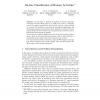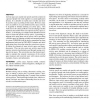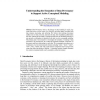2001 search results - page 54 / 401 » Semantic Activity Recognition |
CNSM
2010
13 years 5 months ago
2010
Network control and management techniques (e.g., dynamic path switching, on-demand bandwidth provisioning) rely on active measurements of end-to-end network status. These measureme...
IBPRIA
2007
Springer
14 years 1 months ago
2007
Springer
In this paper we address the problem of on-line recognition of human activities taking place in a public area such as a shopping center. We consider standard activities; namely, en...
HT
1997
ACM
14 years 1 months ago
1997
ACM
Activity spaces are usually task-specific and only common to a group of people who work together in a certain application domain. It is desirable to enable users to define and mod...
ICDE
1999
IEEE
14 years 11 months ago
1999
IEEE
Active database management systems have been developed for applications needing an automatic reaction in response to certain events. Events can be simple in nature or complex. Com...
ER
2006
Springer
14 years 1 months ago
2006
Springer
: Data Provenance refers to the lineage of data including its origin, key events that occur over the course of its lifecycle, and other details associated with data creation, proce...



